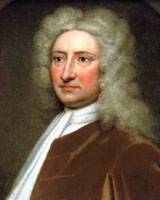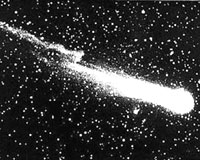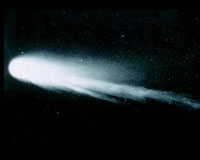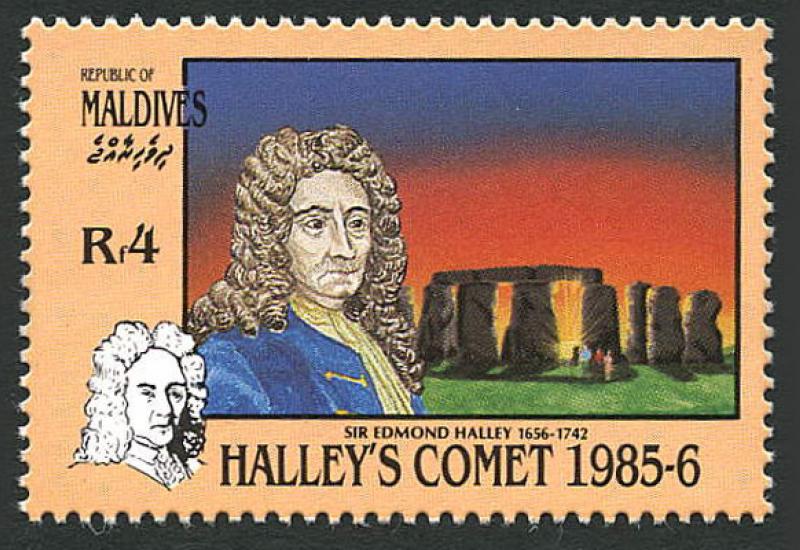The famous English astronomer, mathematician, geophysicist, military engineer, a close friend of Newton - Edmund Halley (actually Halley - Halley) was born on October 29,1656 in the town of Hagerston (near London) ,the son of a prosperous soap-maker. Already in school his extraordinary ability becomes noticeable. Even being only16-year-old schoolboy Halley constructed his first solar watch, and then found out the change in the variation of the magnetic needle, and at the age of 19 he has proposed an improved method of determining the elements of the planetary orbits.
 Inspired by mathematics, at the age of 17 Halley went to Oxford University, where he studied mathematical sciences and philology. Many years later, such different hobbies harmoniously joined together in his translations from Arabic works of Ptolemy and Apollonia Porgskogo. Even before graduation, he was overcome by the desire to do as soon as possible astronomical observations. At that time, there was only a catalog of Tycho Brahe for the northern starry sky. The Catalog of stars in the southern sky, has never observed before due to the northern location of the Tycho Brahe’s observatory. Halley with youthful passion has decided to fill this gap. For this purpose, by a special permission of the king, he went to the island of Saint Helena in the Atlantic Ocean, where one and a half years has tracked the position of 341 stars, which was the basis for compiling a catalog of southern stars, which was included in the third volume of the "History of the Sky" of the Flamsteed. While being on the island of St. Helena, in November 7, 1677 Halley observed the movement of Mercury across the disk of the Sun, which pushed him to the idea of certain important astronomical magnitude - the parallax of the Sun, and therefore, the possibility of determining the distance from Earth to the Sun. The proposed method of determining the solar parallax was used for the transit of Venus across the disk of the Sun in 1761, 1769, 1874 and afterwards.
Inspired by mathematics, at the age of 17 Halley went to Oxford University, where he studied mathematical sciences and philology. Many years later, such different hobbies harmoniously joined together in his translations from Arabic works of Ptolemy and Apollonia Porgskogo. Even before graduation, he was overcome by the desire to do as soon as possible astronomical observations. At that time, there was only a catalog of Tycho Brahe for the northern starry sky. The Catalog of stars in the southern sky, has never observed before due to the northern location of the Tycho Brahe’s observatory. Halley with youthful passion has decided to fill this gap. For this purpose, by a special permission of the king, he went to the island of Saint Helena in the Atlantic Ocean, where one and a half years has tracked the position of 341 stars, which was the basis for compiling a catalog of southern stars, which was included in the third volume of the "History of the Sky" of the Flamsteed. While being on the island of St. Helena, in November 7, 1677 Halley observed the movement of Mercury across the disk of the Sun, which pushed him to the idea of certain important astronomical magnitude - the parallax of the Sun, and therefore, the possibility of determining the distance from Earth to the Sun. The proposed method of determining the solar parallax was used for the transit of Venus across the disk of the Sun in 1761, 1769, 1874 and afterwards.
On his return from the island of St. Helena, being a 22-year-old, Halley has received the academic degree at Oxford University, and was soon elected as a member of the London Royal Society (Academy of Sciences), chaired by Newton. Eventually, E.Galley became the secretary of the Royal Society.
Soon Halley set off to the Western Europe, visiting several observatories, meets Hevelius in Gdansk and senior Cassini in Paris. After traveling, Halley seized by the issue of the planets and comets movement. At the age of 28, he is trying to find a pattern of movement and to associate it with the phenomena of Kepler's laws of gravity of the planets to the Sun, but he meets with the mathematical difficulties. Having learned that the problem was still completely solved by Newton, who did not publish his results, Halley went to consult a scientist at Cambridge. There he succeeded to persuade Newton to publish his ingenious work "Mathematical Principles of Natural Philosophy". Since the Royal Society did not have enough funds for this edition, the Halley published the "Proem" at his own expense.
 Since Halley took up the study of terrestrial magnetism. This issue has a great importance for navigation. By order of the king in 1698 Halley was appointed as a captain of a small ship, which set of to the South Seas, reaching 520 south latitude. In two years of swimming has been collected a lot of material to study the variations of the magnetic needle, which became the basis for the publication of the detailed magnetic maps.
Since Halley took up the study of terrestrial magnetism. This issue has a great importance for navigation. By order of the king in 1698 Halley was appointed as a captain of a small ship, which set of to the South Seas, reaching 520 south latitude. In two years of swimming has been collected a lot of material to study the variations of the magnetic needle, which became the basis for the publication of the detailed magnetic maps.
Returning home in 1703 , Halley headed the astronomical-mathematical faculty in the Oxford University. To deepen his knowledge of the Arabic language, he translated several books of the treatise of Apollonius about the conic sections and the proportional division in a given ratio.
In 1705, Halley made a suggestion that forever linked his name with one of the most famous comets. Finding a method of calculating according to the observations of parabolic orbits, he applied it to the determination of the orbits of several comets, which had previously been observed. He calculated the orbits of 24 comets that had appeared from 1337 till 1608.
However, he found that the comet which appeared in 1531, 1607 and 1682 were moving in almost identical orbits. Moreover, it was found out that in 1456 was seen a comet with such movement, and in the Chronicles was mentioned the comet that appeared in the spring of 1305. The Intervals between the appearance of these comets are multiple of 75-76 years, and the small deviations from strict periodicity can be explained, as it was noted by Halley, perturbations from Jupiter, by the analogy with variations in the periodicity of the motion of Saturn, which was called by the Jupiter. On these grounds, Halley came to the important conclusion that the movement of one and the same comet was observed around the Sun, but a very elongated ellipse, which is almost coincident with the parabola in the part which was available for observations, and he has predicted the appearance of this comet in 1758. But with the approaching of time of the meeting with the comet, indicated by Halley, appeared the suspect in the fallacy of predictions. The famous French mathematician A. Clero and his assistant mathematician Hydrangea Lepot have clarified calculations, taking into account the influence of the movements of Jupiter and Saturn. This influence, as it turned out, has delayed the appearance of the comet for almost a year and a half. The comet was discovered in the last days of 1758, and has passed through perihelion in March 1759.
Since, this comet became known as Halley's comet. She was returned in 1835, 1910, 1986.
In 1715 Halley has published the article "A short message about the cause of the salinity of the ocean and several lakes without runoff, with a proposal to determine the age of the Earth in such way." It was meant that after the evaluation of the annual inflow of salt to the world Ocean, and knowing the amount of salt in all the oceans, it is possible to calculate the period of its accumulation. Three hundred years ago, there was no practical ability to solve this problem, but it is important that Halley is the first person in the history of science who has been found the principal possibility of rational determination of the Earth age.
A year later, Halley has published a memoir concerning the definition of the fundamental unit of length for measuring cosmic distances, namely the distance from the Earth to the sun.
In 1718, another important discovery was made by Halley. While clarifying the constant of precession, he has compared the data in the "Almagest" of Ptolemy (II and III century BC) the position of the stars with his contemporary measurements and found, besides the already known systematic shifts of all the stars, unexpected new developments (tens of minutes) of latitude in the three brightest stars - Sirius, Aldebaran, Arcturus. Halley compared the coordinates with an exact catalogue of Tycho Brahe, other observations and concluded that these stars change their position in space, consequently, their position in the sky should be changed. So there was one of the most important discoveries in astronomy - the discovery of the proper motion of stars. By that time all the stars were considered fixed. This idea was accepted by all astronomers after the German observer Toviya Mayer in 1775, by comparing the position of stars according to Remer (1706) with observations of Laquila (1750 - 1754) and his own, has established the existence of a proper motion of more than fifty stars. So, the ancient name of "fixed stars" has lost all meaning.
 Halley’s research in other fields of science has also left a deep impression. In particular, he was the first who was applied poor, at the time, mathematical science - probability theory - in public life and became the founder of statistics in England (compiled the first tables of insurance, using a new approach to the study of mortality).
Halley’s research in other fields of science has also left a deep impression. In particular, he was the first who was applied poor, at the time, mathematical science - probability theory - in public life and became the founder of statistics in England (compiled the first tables of insurance, using a new approach to the study of mortality).
Halley also found the barometric formula for determining heights, used conic sections to solve cubic equations and biquadratic, proposed methods of computing logarithms and trigonometric functions.
In 1720, at the age of 64, Halley was appointed Director of the Royal Greenwich Observatory, being awarded with a title of "The Royal astronomer". On this post a special attention was given to the study of the movement of the moon with the intention to give a solid basis for the application of astronomy to navigation and, in particular, to determine longitude at sea. For the solution of this task the authorities have appointed a state premium. For its solution it is necessary to compile accurate tables of the moon's motion, and therefore to conduct multiple observations and clarify the theory of lunar motion, which was the extremely difficult task of celestial mechanics. Halley completed the task after observing the total circulation period of the nodes of the lunar orbit that took a whole 18 years. Fluently, he discovered the secular acceleration of the moon's motion, which was much later studied by Laplace. He also showed great long-period inequalities in the motion of Jupiter and Saturn, which suggests a close commensurability in the periods of rotation of these planets.
Halley was died on 14 January 1742, but the comet named after him will again appear in earth's sky in 2061 ...

